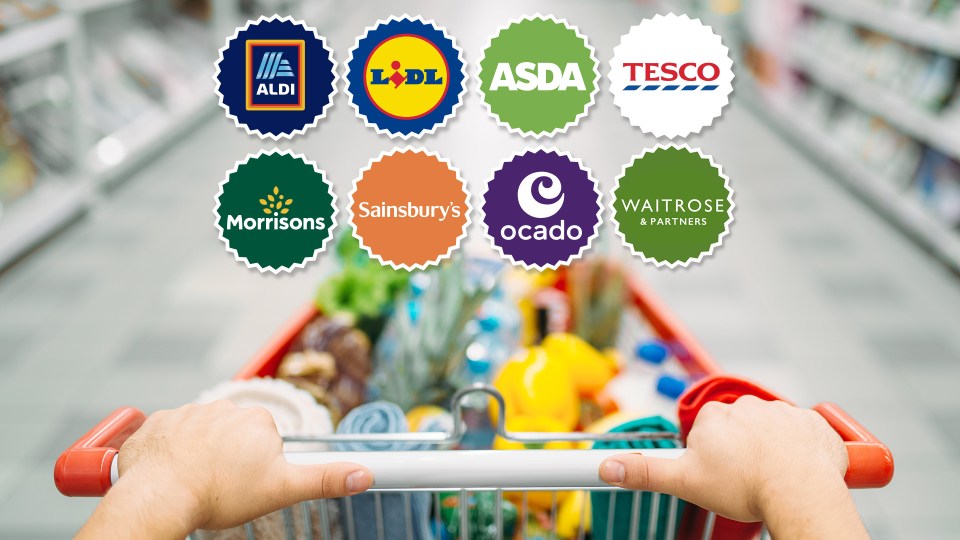THE UK’s cheapest supermarket for the most recent month has been named – and it could save you more than £40 on your food shop.
Consumer group Which? looked at the cost of 79 essential groceries at the biggest supermarkets in March.
Aldi has been crowned the cheapest, with the list of groceries coming in at £133.73 on average across the month.
The list of items included both branded and own-brand items, such as Birds Eye peas, Hovis bread, milk and butter.
The Aldi shop was a huge £42.68 cheaper than the most expensive supermarket, Waitrose.
A shopper at Waitrose would have spent £176.41 for the same or similar items.
Coming in closely behind Aldi as the cheapest was its discount supermarket rival Lidl.
It cost only 67p more at £134.40 with the supermarket’s loyalty scheme Lidl Plus, while it was 70p more without at £134.43.
The next cheapest was Tesco at £146.79, but only if you held a Clubcard.
Asda shoppers could get the list of 79 items for £147.09.
Meanwhile Tesco shoppers without a Clubcard would pay £149.83.
Here is how the rest of the supermarkets fared:
- Sainsbury’s (with Nectar) – £150.46
- Morrisons (with More) – £155.47
- Morrisons (without More) – £156.86
- Sainsbury’s (without Nectar) – £159.24
- Ocado – £167.20
Reena Sewraz, Which? retail editor, said: “Aldi has once again been crowned as the UK’s cheapest supermarket in our monthly price analysis, however, Lidl has narrowed the gap with its rival.
“It was also a strong month for Asda, as it continues to be the cheapest supermarket for a bigger list of groceries.”
She added that by switching supermarkets, shoppers could pay 24% less – so it’s always best to shop around where possible.
Which? also looked at a bigger list of 203 essential items.
Aldi and Lidl were not included in this bigger list because they have a smaller range of branded products compared to the other supermarkets.
Asda came out the cheapest at £498 – and it was a huge £75.15 cheaper than the most expensive supermarket, Waitrose.
A bigger shop at Waitrose cost £573.15, or 15% more than at Asda.
The second cheapest bigger shop was at Tesco, with the list of items coming out at £503.03 for those with a ClubCard.
Here’s how the other supermarkets did:
- Sainsbury’s (inc loyalty discount) – £515.79
- Morrisons (inc loyalty discount) – £522.27
- Morrisons (without loyalty discount) – £534.80
- Tesco (without loyalty discount) – £540.63
- Ocado – £553.46
- Sainsbury’s (without loyalty discount) – £559.66
Which? checks the prices of hundreds of grocery items at the eight major supermarkets throughout the year.
It works out the average price of each item across the month and then adds those up to get an average price.
Although own-brand items won’t be identical, Which? says everything it compares is as similar as possible based on factors such as quality and weight.
How to save money on your food shop

Consumer reporter Sam Walker reveals how you can save hundreds of pounds a year:
Odd boxes – plenty of retailers offer slightly misshapen fruit and veg or surplus food at a discounted price.
Lidl sells five kilos of fruit and veg for just £1.50 through its Waste Not scheme while Aldi shoppers can get Too Good to Go bags which contain £10 worth of all kinds of products for £3.30.
Sainsbury’s also sells £2 “Taste Me, Don’t Waste Me” fruit and veg boxes to help shoppers reduced food waste and save cash.
Food waste apps – food waste apps work by helping shops, cafes, restaurants and other businesses shift stock that is due to go out of date and passing it on to members of the public.
Some of the most notable ones include Too Good to Go and Olio.
Too Good to Go’s app is free to sign up to and is used by millions of people across the UK, letting users buy food at a discount.
Olio works similarly, except users can collect both food and other household items for free from neighbours and businesses.
Yellow sticker bargains – yellow sticker bargains, sometimes orange and red in certain supermarkets, are a great way of getting food on the cheap.
But what time to head out to get the best deals varies depending on the retailer. You can see the best times for each supermarket here.
Super cheap bargains – sign up to bargain hunter Facebook groups like Extreme Couponing and Bargains UK where shoppers regularly post hauls they’ve found on the cheap, including food finds.
“Downshift” – you will almost always save money going for a supermarket’s own-brand economy lines rather than premium brands.
The move to lower-tier ranges, also known as “downshifting” and hailed by consumer expert Martin Lewis, could save you hundreds of pounds a year on your food shop.








